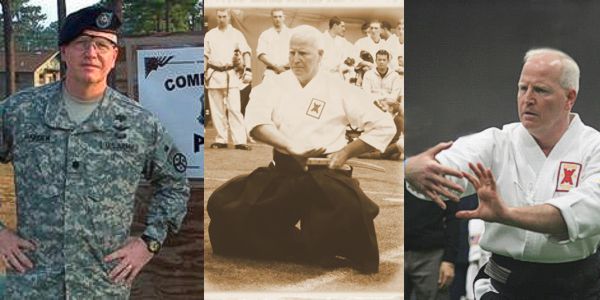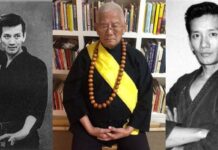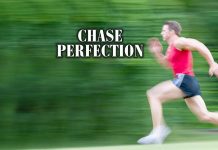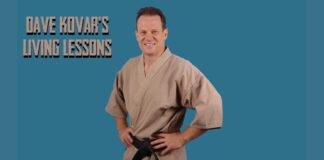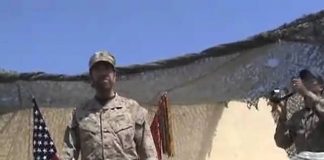Satsuninken and Katsuninto, the swords of death and life, are a metaphor regarding balance, center, and free will.
“Go seek balance Daniel-san,” these were the words Miyagi Sensei spoke to his pupil at a time in Daniel’s life when he needed help. All of us face challenging times in our lives. Those times require fortitude, discipline, persistence, bravery, and a balanced approach in order to properly address our difficulties. The swords of life and death are a metaphor regarding balance, center, and free will. In the old film The Karate Kid this idea was exemplified and ultimately proven in Daniel’s personal realization, “that you train so you do not have to fight.” It was poignantly emphasized by his teacher’s response: “Ah, Daniel-san, Miyagi has hope for you!”
It is an interesting reiteration of O’Sensei’s teachings and relates well to the discussion of balance and its relationship to the two swords. Also, interestingly enough, whom we choose to study under and learn from will effect what we will ultimately become as we shape our own destiny and sharpen our swords through our training, study, and teaching. This was clearly demonstrated by the protagonist in the movie who advised his students that “there is no sympathy in this dojo” and that “mercy is for the weak.” O’ Sensei would take the more benevolent approach, but only after a lifetime of learning through challenges, struggles, and uncommon life experiences. The challenges we face are like a forge and anvil. We are shaped in the sword smith’s shop of life experience. The yin and yang concepts in all evil there can be some good and in all good there can be some evil point to this duality of natural law as it can be related to our choices. This then is a discussion of my life experience and my relationship with the concept of the two swords.
The highs and lows of our lives balance each other and give us strength and depth. This is as true today as it ever was in ancient Japan. Munenori Yagyu wrote of these concepts in his treatise on the swords of life and death. He spoke of the existence of these two spirits and that they often coexist, even in the same individual. Ultimately this duality of nature is seen in everything and everyone. O’Sensei recognized it on his martial pathway through life and his experience with war and peace. I can relate deeply to the healing aspects of martial ways, particularly from the unique view of an old soldier who has spent many years witnessing the very best and very worst that human nature has to offer. The very real effects of which sword was chosen for use! This was a reason for my resurgence of interest in the art of peace, Aikido. I was drawn back to these foundations specifically because of life experiences from war torn Bosnia. It was in that crucible that I began to search for a higher meaning to the warrior spirit, the idea of bushido and honor and the martial values of strength through true benevolence and love for humanity, rather then striking, kicking, or destroying. In Aikido, we guide the attacker to a point of control and hopefully understanding through a position of strength and resolve. In essence we use both swords simultaneously and in balance with each other.
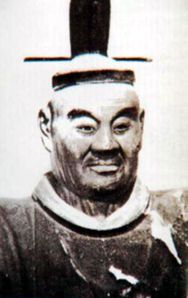 It is a universal idea that my Taekwondo instructor (Jhoon Rhee) often referred to as “might for right.” It relates to many difficult philosophical concepts like “takemusu aiki” which I rather loosely interpret as “Aikido, can be found in everything we do and say.” It might well be related to these choices that an individual can find balance in their life. O’Sensei referred to this as “standing on a floating bridge.” Based on our choices, we determine the direction the bridge will tip. The direction our spirit will follow and by keeping the bridge in balance we have the key to bliss, true aiki, love and benevolence at the center of our lives. These are the true swords of the human existence.
It is a universal idea that my Taekwondo instructor (Jhoon Rhee) often referred to as “might for right.” It relates to many difficult philosophical concepts like “takemusu aiki” which I rather loosely interpret as “Aikido, can be found in everything we do and say.” It might well be related to these choices that an individual can find balance in their life. O’Sensei referred to this as “standing on a floating bridge.” Based on our choices, we determine the direction the bridge will tip. The direction our spirit will follow and by keeping the bridge in balance we have the key to bliss, true aiki, love and benevolence at the center of our lives. These are the true swords of the human existence.
The westerner in me cannot help but think of Christian scripture and its relationship to this balance between the swords of life and death. In the Genesis, 1:26, verse 27, we read, “Let us make man in our image, after our own likeness, and we were created in his image” (a sword of life?). In Romans 3:23, we find that “all have sinned and fallen short of the glory of God.” Essentially, I think these scripture verse refer to our ability to choose a sacred path, or the profane. The two swords of life and death are the duality argument and our freedom of choice is part of this universal wisdom. It is not isolated to oriental thought and philosophy; “takemusu-aiki” can be found anywhere you choose to look for it, even in Old Testament Hebrew verse.
With that introduction to my understanding of the philosophy of the swords, it is through the control of our actions, or the lack thereof, that we are ultimately responsible for the direction of our path because of our choices. What we choose to say or do effects our pathway; there is always an influence, an effect, and a choice always! Here is an example of the curve ball, what the strategists call the “Third Order Effect:” When seeking a teacher do we look for a balance in them, or their approach? The word “sensei” means “one who has come before,” and the relationship they choose and the direction our teacher’s lead us in can impact our decisions; who we will eventually become can be shaped by their influence. Classically, I see the two swords of influence when reading about O’Sensei’s experiences with his teachers Unisaburu and Sokaku Takeda. If ever there were two different approaches to teaching and life, they are classic examples. Who we choose to call Sensei is one of the most important decisions we make and it is often given little thought other then cost, style, and convenience. What are you being taught and why should be considerations as they effect who we become and how we weld our swords (perhaps some food for thought for future students?). The role of the “chu” and that pathway to the center and balance is a paramount decision. Balance is the true nature of martial art, of life, and this duality of the swords and a centered approach is seen in many other martial concepts. It is also seen in the ideas of yin and yang, hard and soft, fire and water, earth and wind the constant duality of life that shapes our ability to choose, to lead, is the all-important aspect to consider when finding the center path. Making the right choice of which sword to wield, and when, is effected by many influences. Interpreting these influences correctly and with honor is the ultimate challenge for every martial artist and, really, every human being.
As part of the training process Aikidoka of the Yoshinkan discipline are required to write about various topics on martial Satsuninken, “The Sword of Death” philosophical ideas. My teacher, Kevin Blok Sensei, asks that I try to bring in personal reflection from my own experiences. “Make the discussion personal to you, find things in your background that are unique to you, apply them to the idea of a lifegiving sword, or a sword of death. Give some examples of this from your own history and relate these ideas to the overall topic.” On the surface, this seems rather straight forward, but the more I have pondered this assignment, the more my thoughts on this topic have evolved. With that in mind, I have spent the last year thinking about exactly what Yagyu Munenori reflected upon in his book from sixteenth century feudal Japan. How do I relate these concepts to my own life experiences? What lessons has life taught me about true balance, about life, and ultimately death? These are very hard questions for anyone to answer, but I found them particularly painful, as I thought of the two swords it was all very personal to me because of my experiences. Indeed, there is a deep well draw upon. As the saying goes, “Just like the sword, the student never likes to be sharpened!” Swords of death are all around us, as are the swords of life. The examples are there in view for all to see, but this has to be something personal, something that has impacted me in some profound way. Stories from the heart matter, at least from my limited understanding at this point in my journey.. So here are two life examples of what I think are the swords of life and death.
The year was filled with turmoil. My wife had just finished Pharmacy School and she had just given birth to our son, Joshua. It was the most fulfilling moment of my life and we were so very happy because everything was really going so well. Life was good and all our hard work was paying off. I had even been promoted to Captain in the Army, right when we really needed that bump in pay. That all lasted about two months after my son was born and then things changed in a drastic way. I was mobilized and sent overseas to serve as a flight surgeon with an aviation asset that was supporting infantrymen in Bosnia and Kosovo. I was gone for the next eighteen months and lived among the death of those killing fields, land mines, and all the atrocities that come along with a war based on ethnic or religious hatred. Bosnia is my idea of what Munenori might have meant by a sword of death (satsuninken). As a samurai of old, he must have seen swords welded by fanatics who felt they were patriots in some just cause. This duality of martial arts and of life is also based on your perspective. One man’s freedom fighter is another mans terrorist, as the popular saying goes in Afghanistan. But it was in Bosnia that I truly first witnessed the atrocities of war on a scale that perhaps only a soldier could understand. With that destruction and death comes a deeper appreciation for our freedom and the need to honor the fragility of life. Experience at that level teaches the depths of our nature as human beings. It is that aspect that the two swords can be found living together in all of us, and choice is the only thing that separates honor from evil.
The one example of this idea of satsuninken truly stood out from all the others I experienced occurred near the small village of Potocari close to the larger town of Srebrenica. The experiences of those town’s people was spawned from religious differences and ethnic hatred. It was generations old and so well ripened that it triggered an ethnic cleansing on a level that had not been witnessed since World War II and the Nazi programs carried out against the Jews. Rape, murder, and torture were the order of the day.
My unit was tasked with providing security during Potocari’s first memorial ceremony for the massacre that had occurred there, just one year before. Literally hundred’s of families were killed, tens of thousands were displaced and brutalized. Emotions ran high and the wounds were still visible and deep. The rhetoric from the two sides flared while we were there. Small pockets of violence eventually erupted and as the senior medical officer, I was involved in treating and managing the injured residents. It was to be a challenging day but in the end we secured the peace and the ceremony was held and the corner stone for peace was laid, or at least so we thought.

Satsuninken is an ancient sword, but it will forever remind me of a young teenage girl, brutally raped and beaten to death the night after the remembrance ceremony had occurred. We had maintained the peace, while we were there, but once we left that young girl was used as an example. We found her dead face down at the foot of the memorial cornerstone dedicated to peace, demonstrating to us that for peace to be maintained strength must exist and honor must prevail. But these are the difficult concepts when you add in the poison of hatred. There are always those third order effects you cannot anticipate.
That is the balance implied by the two swords scenario. It is not the sword that is at fault, but the person welding the power of that sword. That power can intoxicate and corrupt. That is why a disciplined approach to warrior arts is so key in understanding that the true lessons of satsuninken. Some of the lessons can have positive effects, trigger growth and lead to a deeper commitment, propelling us to an even higher ideal of honor in all things and understanding what our duty should be. To be balanced and centered in our lives, especially on a battlefield it can be a challenge, and therein lies the ambiguity of this assignment and for me: the difficult nature of discerning these two principles. Ultimately your judgment is what determines which sword you use, and which one you will represent through your actions.
Your judgment can be the sword of life, or death, and the sword of death can strike in many strange ways.
Katsuninto, “The Sword of Life”
I had just returned from a rotation in Iraq. I had been home for a few months and was beginning to reset into a civilian routine. That is when my story of the sword of life occurred. I think the sword of life means something more then this in that your actions are really never ending. It was revealed to me in the form of a letter from a family member regarding the love of their child and of a gift that I had unknowingly given them.
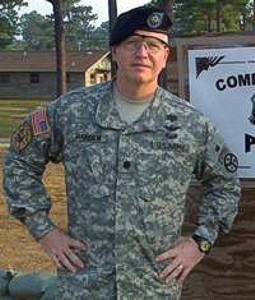 As a flight surgeon in the Army one of my main responsibilities is trauma medical evacuation of wounded soldiers. As part of this we are required on occasion to go to the point of injury. Obviously, this takes us into harm’s way in order to secure, treat, and route injured troopers to appropriate levels of definitive care. Arguably, the very definition of both of these ideas can be found in that mission statement. I flew into Fallujah and had evacuated a young Marine. He was pretty busted up and needed intravenous fluids to prevent shock. He had a major airway issue that required chest tube placement and immediate air evacuation. All of these things were done as a matter of course through a well-trained response to injury treatment. It was pretty much “text book”. I was able to successfully move this young injured Marine back to the evacuation hospital where he would get definitive care for his many wounds. A job “Well Done” was the response from my commanding officer. I went on to other missions, other soldiers, and had long since forgotten about that injured Marine. I moved on, which you have to do, or bad things can happen to you.
As a flight surgeon in the Army one of my main responsibilities is trauma medical evacuation of wounded soldiers. As part of this we are required on occasion to go to the point of injury. Obviously, this takes us into harm’s way in order to secure, treat, and route injured troopers to appropriate levels of definitive care. Arguably, the very definition of both of these ideas can be found in that mission statement. I flew into Fallujah and had evacuated a young Marine. He was pretty busted up and needed intravenous fluids to prevent shock. He had a major airway issue that required chest tube placement and immediate air evacuation. All of these things were done as a matter of course through a well-trained response to injury treatment. It was pretty much “text book”. I was able to successfully move this young injured Marine back to the evacuation hospital where he would get definitive care for his many wounds. A job “Well Done” was the response from my commanding officer. I went on to other missions, other soldiers, and had long since forgotten about that injured Marine. I moved on, which you have to do, or bad things can happen to you.
In the mail one day about a year after I had returned home from Iraq there was a letter addressed to MAJOR Harden (my rank at the time of my service in Iraq). The letter was dog-eared and dirty. It had come to me by way of the Army Post Office, New York, and sent through Karachi, Pakistan then re-routed to my permanent residence in southwest Virginia. When I opened it and read the note it brought tears to my eyes. It was from the grandfather of that young Marine. He was thanking me for what I had done for his grandson, but it was also much more then just a thank you. He had taken the time to find out who the flight doc on duty was during his grandson’s initial injuries. No small task there. As he wrote the note, I realized he was writing to more then just me. He told the story of his own extensive injuries from World War II. He detailed how guilty he felt over the last fifty years that he had never been able to tell the medics who evacuated him his own “thank you,” and so he was taking this opportunity to thank me for caring for his grandson, and also in a way, he was thanking the medics from that war fought more then half a century before for his own life, the fruit it had obviously borne. Only a soldier truly realizes the price of freedom, and the cost of wielding those damned swords!
This to me is the nature of the life-giving sword. We are all interconnected. I am sure those medics on that battlefield in Nazi Germany never thought the person accepting thanks for what they did, who had not even been born yet, would be fighting in a war to save the grandchild of the man they had saved all those years ago.
The sword of life can strike in many strange ways.
OSU!
Dane-san

